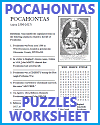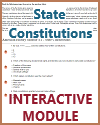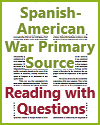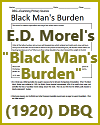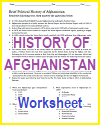The French and Indian War |
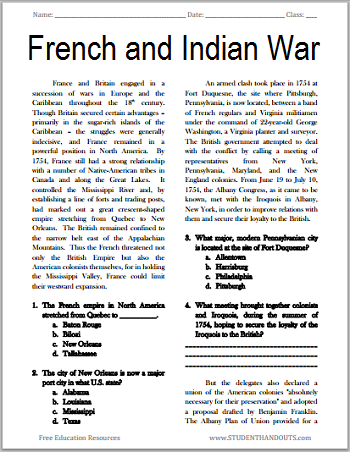 France and Britain engaged in a
succession of wars in Europe and the Caribbean throughout
the 18th century. Though Britain secured certain advantages
– primarily in the sugar-rich islands of the Caribbean – the
struggles were generally indecisive, and France remained in
a powerful position in North America. By 1754, France still
had a strong relationship with a number of Native-American
tribes in Canada and along the Great Lakes. It controlled
the Mississippi River and, by establishing a line of forts
and trading posts, had marked out a great crescent-shaped
empire stretching from Quebec to New Orleans. The British
remained confined to the narrow belt east of the Appalachian
Mountains. Thus the French threatened not only the British
Empire but also the American colonists themselves, for in
holding the Mississippi Valley, France could limit their
westward expansion. France and Britain engaged in a
succession of wars in Europe and the Caribbean throughout
the 18th century. Though Britain secured certain advantages
– primarily in the sugar-rich islands of the Caribbean – the
struggles were generally indecisive, and France remained in
a powerful position in North America. By 1754, France still
had a strong relationship with a number of Native-American
tribes in Canada and along the Great Lakes. It controlled
the Mississippi River and, by establishing a line of forts
and trading posts, had marked out a great crescent-shaped
empire stretching from Quebec to New Orleans. The British
remained confined to the narrow belt east of the Appalachian
Mountains. Thus the French threatened not only the British
Empire but also the American colonists themselves, for in
holding the Mississippi Valley, France could limit their
westward expansion.1. The French empire in North America stretched from Quebec to __________. a. Baton Rouge b. Biloxi c. New Orleans d. Tallahassee 2. The city of New Orleans is now a major port city in what U.S. state? a. Alabama b. Louisiana c. Mississippi d. Texas An armed clash took place in 1754 at Fort Duquesne, the site where Pittsburgh, Pennsylvania, is now located, between a band of French regulars and Virginia militiamen under the command of 22-year-old George Washington, a Virginia planter and surveyor. The British government attempted to deal with the conflict by calling a meeting of representatives from New York, Pennsylvania, Maryland, and the New England colonies. From June 19 to July 10, 1754, the Albany Congress, as it came to be known, met with the Iroquois in Albany, New York, in order to improve relations with them and secure their loyalty to the British. 3. What major, modern Pennsylvanian city is located at the site of Fort Duquesne? a. Allentown b. Harrisburg c. Philadelphia d. Pittsburgh 4. What meeting brought together colonists and Iroquois, during the summer of 1754, hoping to secure the loyalty of the Iroquois to the British? But the delegates also declared a union of the American colonies "absolutely necessary for their preservation" and adopted a proposal drafted by Benjamin Franklin. The Albany Plan of Union provided for a president appointed by the king and a grand council of delegates chosen by the assemblies, with each colony to be represented in proportion to its financial contributions to the general treasury. This body would have charge of defense, Native-American relations, and trade and settlement of the west. Most importantly, it would have independent authority to levy taxes. But none of the colonies accepted the plan, since they were not prepared to surrender either the power of taxation or control over the development of the western lands to a central authority. 5. Who drafted the proposed Albany Plan of Union? a. Benjamin Franklin b. John Adams c. John Dickinson d. Thomas Jefferson England's superior strategic position and its competent leadership ultimately brought victory in the conflict with France, known as the French and Indian War in America and the Seven Years' War in Europe. Only a modest portion of it was fought in the Western Hemisphere. 6. The French and Indian War is known by what name in Europe? In the Peace of Paris (1763), France relinquished all of Canada, the Great Lakes, and the territory east of the Mississippi to the British. The dream of a French empire in North America was over. 7. Which of the following was not surrendered by France in the Peace of Paris? a. Canada b. Great Lakes c. Territory east of the Mississippi d. Virginia Having triumphed over France, Britain was now compelled to face a problem that it had hitherto neglected, the governance of its empire. London thought it essential to organize its now vast possessions to facilitate defense, reconcile the divergent interests of different areas and peoples, and distribute more evenly the cost of imperial administration. In North America alone, British territories had more than doubled. A population that had been predominantly Protestant and English now included French-speaking Catholics from Quebec, and large numbers of partly Christianized Native Americans. Defense and administration of the new territories, as well as of the old, would require huge sums of money and increased personnel. The old colonial system was obviously inadequate to these tasks. Measures to establish a new one, however, would rouse the latent suspicions of colonials who increasingly would see Britain as no longer a protector of their rights, but rather a danger to them. 8. facilitate: a. expedite b. hinder c. prohibit d. thwart |
| Answer Key: 1. C - New Orleans; 2. B - Louisiana; 3. D - Pittsburgh; 4. Albany Congress; 5. A - Benjamin Franklin; 6. Seven Years' War; 7. D - Virginia; 8. A - expedite. |
Click
here
to print this worksheet. |
 |
|---|
| Colonial Period Books and Films | Colonial Period Learning and Study Games |
| Colonial Period Image Galleries | Colonial Period Outlines and PowerPoints |
| Colonial Period Miscellany | Colonial Period Worksheets |
| Text Courtesy of the U.S. State Department, Bureau of International Information Programs, 2005 |


